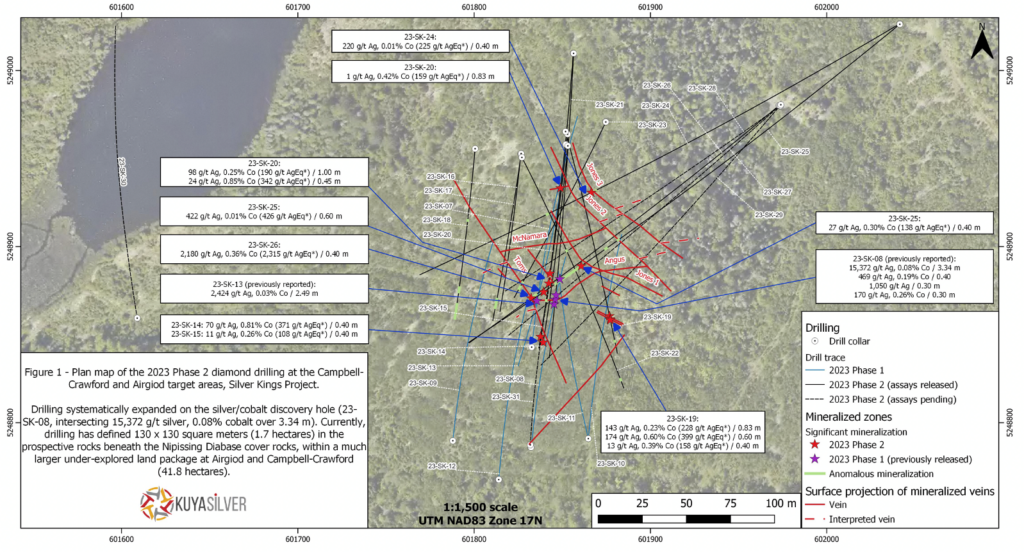
Kuya Silver Expands Mineralized Vein Zone in Phase 2 Drilling at Campbell-Crawford Target, Silver Kings Project
Newly-defined Toms Vein assays 2,180 g/t silver and 0.36% cobalt over 0.40 m within wider zone assaying 199 g/t silver over 7.00 m
Six drill holes from Campbell-Crawford and Airgiod target areas are pending and visible silver and/or cobalt mineralization was observed in all remaining drill holes
Kuya Silver Corporation (CSE: KUYA) (OTCQB: KUYAF) (Frankfurt: 6MR1) is pleased to present the first assay results from a diamond drilling program at the grassroots Campbell-Crawford target area, at its wholly-owned Silver Kings Project, where drilling in March 2023 intersected high-grade silver in a new grassroots vein structure. Results from holes 23-SK-14 to -26 are presented; in total, 18 oriented NQ drill holes were completed (23-SK-14 to -31) for a combined total of 5,834 m in this program. With additional diamond drilling performed in this target area, Kuya Silver is identifying a cluster of mineralized veins in proximity to the Angus Vein discovery, often in intersecting orientations, which is similar and comparable to other major historical mines in the Cobalt camp.
Highlights:
- Diamond drilling was focused on defining the geometry and grade of mineralized structures in the Campbell-Crawford area, following up on the March 2023 grassroots Angus Vein drill intercept of 15,372 g/t silver over 3.34 m
- Six major, variably-mineralized and traceable veins were intersected in drilling, plus secondary veins, with dominantly E-W, NW-SE and NNE-SSW trends
- Up to seven mineralized veins intersected per drill hole
- Veins commonly bend and pinch and swell along trend, and high-grade mineralization is commonly localized in these bends and at (or near) vein intersections
- Drilling tested a relatively restricted subsurface area of approximately 1.7 ha (130 x 130 square meters) within the ideal mineralized horizon at depth. The total size of the Campbell-Crawford and Airgiod properties is 41.8 ha
- Results from the newly-recognized Toms Vein include 2,180 g/t (70 oz/t) silver, 0.36% cobalt (2,315 g/t AgEq*) over 0.40 m in hole 23-SK-26 within a wider mineralized zone assaying 199 g/t (6.4 oz/t) silver, 0.02% cobalt (208 g/t AgEq*) over 7.00 m
- Original Angus Vein silver intersection from hole 23-SK-08 (15,372 g/t silver over 3.34 m) traced 70 m deeper with cobalt-rich intercept in hole 23-SK-20 from 314.79 m, with 8.70 g/t silver, 0.26% cobalt over 2.41 m (108 g/t AgEq*; from 314.79 m), including 24 g/t silver, 0.85% cobalt over 0.45 m (342.43 g/t AgEq*)
- Six drill holes from Campbell-Crawford and Airgiod target areas are pending
- Visible silver and/or cobalt mineralization observed in all remaining drill holes
David Lewis, Vice President Exploration, commented: “When we first drilled the Angus Vein in March, 2023, there was no doubt about the buried potential for new economic deposits at the Campbell-Crawford property. We have now begun defining at least six E-W and NW-SE trending mineralized veins, plus smaller secondary veins, within a very tight area, and hints of other major veins have also been drilled. We are observing higher-grade silver and cobalt mineralization focused near flexed vein intersections, defining steep, cigar shaped mineralized shoots, and there is potential at each of these major vein intersections for additional mineralized shoots. The remaining six drill holes were designed to follow up on the main Angus Vein intersection but also include one hole testing the Airgiod property at depth and all intersected visible silver and/or cobalt mineralization. Both the Campbell-Crawford and Airgiod areas remain extremely promising and high-priority exploration targets for Kuya Silver.”
Table 1: Significant silver and cobalt mineralization intersected in the Phase 2 2023 drill program at the Campbell-Crawford target area. Results from the first twelve drill holes (23-SK-14 to -26) are presented, with the remaining six pending. AgEq* (silver equivalent) grades were calculated using $23.69 USD / oz silver and $28,500 USD / tonne cobalt, with metal prices captured on January 2, 2024. Mineralized drilling intervals do not reflect true interval length. “BMZ” refers to mineralization within a Broader Mineralized Zone. *Assaying by Screened Metallics was conducted on high-grade, visually identified silver mineralization in hole 23-SK-26 between 256.80 m to 258.80 m. See Appendix A for full significant and anomalous assay results.
Figure 1: Plan map of the 2023 Phase 2 diamond drilling at the Campbell-Crawford and Airgiod target areas, Silver Kings Project.
Campbell-Crawford Drilling Expanded
Drilling at the Campbell-Crawford target area has successfully identified at least six steeply-dipping silver-cobalt mineralized veins with significant lateral and vertical extent at depth, as well as a variety of secondary mineralized veins (Table 1; Figure 1). The veins cut both the basal Archean volcano-sedimentary rocks and the overlying Nipissing Diabase sill (exposed on surface to 200+ m depth), but the mineralization increases dramatically below this rock contact. These steep silver-cobalt veins include the previously-recognized E-W trending Angus and McNamara veins, as well as four newly-identified NW-SE trending veins, including the Toms, Jones 1, Jones 2 and Jones 3 veins. A significant number of secondary mineralized veins, typically drilled near flexures or intersections of the major veins, were also intersected.
High-grade silver and cobalt mineralization is largely restricted to the mineralized veins, but minor haloed intervals can also occur in the surrounding wall rock. Based on the initial six drill holes from the early 2023 drill program (23-SK-07 to -13), mineralization was interpreted to follow the shallowly-dipping lower diabase contact; further drilling now shows that mineralization plunges steeply in both E-W and NW-SE veins. Currently, high-grade zones are known near vein intersections and in vein flexures, only one of which has now been properly tested, and the basal Archean rock geometry also likely affects veining. Historically, in the Cobalt mining camp, clusters of closely-spaced mineralized vein structures with different orientations have the potential to host larger (i.e. >5 million ounce silver plus cobalt) deposits.
The basal Archean rocks, located beneath the Nipissing Diabase sheet, consist of mafic volcanic, volcaniclastic, interflow sedimentary, and felsic intrusive rocks. The sedimentary rocks, which are traceable between drillholes, are highly enriched in base metal sulphides, and mineralized silver-cobalt veins are clearly influenced by these interflow sulphide zones. The sulphides, which locally grade up to several percent copper, lead and/or zinc, are also locally enriched in arsenic, silver and cobalt. The silver-cobalt veins frequently cut these interflow sedimentary rocks, but the relationship between the veins and sulphidized sedimentary rocks remains unclear.
Drill Program Details and Interpretations
Table 2: Description of drill targeting and mineralized results for drill holes 23-SK-14 to 23-SK-26. Sample widths do not reflect true thickness of mineralization.
The 2023 Phase 2 drill program was divided into several stages of work. Early drill holes (23-SK-14 to -20) were designed as step-out drill holes to the original major drilling intersections (23-SK-08 and -13; see Kuya Silver May 30, 2023 news release) in order to test vein continuity (both vertically and along trend). The first drill hole in the program, 23-SK-14, used the same pad as hole 23-SK-13, but the hole was drilled more shallowly. Drilling step-outs were designed to be on 25 m centers, both to the east and the west of this original pad, and multiple holes per pad were drilled with different dips. Later drill holes (23-SK-21 to -29) were designed to test vein intersections in progressively more detail. Hole 23-SK-30 was designed to test beneath Cyril Lake (Figure 1), an interpreted fault valley, and hole 23-SK-31, originally designed as a wedged hole from 23-SK-08, had to be drilled as an infill hole from surface when the wedge failed and jammed in hole 23-SK-08. A summary of drilling, including drill targets and results, is presented in Table 2 and drill hole coordinates and orientations are presented in Table 3.
In the late stages of the drilling program, a borehole optical televiewer was used in five drill holes (23-SK-08, -18, -19, -29 and -31) to establish and/or verify vein orientations from the oriented drill core program. This work was performed by DGI Geoscience Inc. based in Toronto, Ontario. Currently, data from two drill holes (23-SK-08 and -19) has been returned.
Table 3: Collar coordinates and drill orientations from the 2023 Campbell-Crawford and Airgiod area Phase 2 drilling. All units are in meters and coordinates are presented in UTM NAD83 Zone 17N.
Quality Assurance and Quality Control
The drill core samples were logged and sampled with limestone blank material and standard reference material added in sample sequence and/or following visual identification of silver or cobalt mineralization. The samples were cut perpendicular to veining by core saw and were secured in labelled vinyl sample bags. Samples were shipped to AGAT Laboratories in Timmins, Ontario, where they were weighed, crushed and pulverized.
At AGAT Labs (Calgary, Alberta), samples were digested by 4-acid and analyzed by ICP-OES (maximum undiluted detection limit of 500 g/t silver).
At SGS Labs (Lakefield, Ontario), samples were processed by 500 g Screened Metallics. This method is suitable for coarse native metals (e.g. gold, silver, copper, palladium and platinum) with no upper detection limit. Samples were screened to 106 microns and fire assayed.
When samples were analyzed for silver by both ICP-AES and Screened Metallics, the Screened Metallics results are presented. A single QA/QC standard processed by Screened Metallics returned a value below two standard deviations for silver; all other QA/QC standards were acceptable and within two standard deviations of certified values.
National Instrument 43-101 Disclosure
The technical content of this news release has been reviewed and approved by Mr. David Lewis, P.Geo., Vice President Exploration of Kuya Silver and a Qualified Person as defined by National Instrument 43-101.
About Kuya Silver Corporation
Kuya Silver is a Canadian‐based mineral exploration and development company with a focus on acquiring, exploring, and advancing precious metals assets in Peru and Canada.
MORE or "UNCATEGORIZED"
Ascot Announces Closing of C$34 Million Bought Deal Financing
Ascot Resources Ltd. (TSX: AOT) (OTCQX: AOTVF) is pleased to anno... READ MORE
RUA GOLD Closes C$8 Million Brokered Offering and Announces Commencement of Trading on the TSX Venture Exchange
Highlights Closing the fully subscribed brokered offering for C$8... READ MORE
Mosaic Acquires 100% of the Amanda Project
Mosaic Minerals Corporation (CSE: MOC) announces that it has sign... READ MORE
First Phosphate Confirms Significant High-Quality Igneous Phosphate Deposit at Its Bégin-Lamarche Project in the Saguenay-Lac-St-Jean Region, Quebec au Canada
First Phosphate Corp. (CSE: PHOS) (OTC: FRSPF) (FSE: KD0) is ple... READ MORE
PROSPECT RIDGE ANNOUNCES FINAL CLOSING OF ITS OVERSUBSCRIBED PRIVATE PLACEMENT
Prospect Ridge Resources Corp. (CSE: PRR) (OTC: PRRSF) (FRA: OE... READ MORE

















